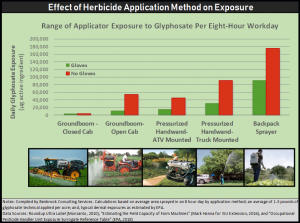The U.S. federal pesticide law is called the Federal Insecticide, Fungicide, and Rodenticide Act, or FIFRA.
Ever wonder why FIFRA seems so feckless in dealing with the deepening economic, ecological, and public health problems arising from excessive reliance on herbicides in major row-crop weed management systems?
Might no “H” in FIFRA have something to do with it?
Our latest “In the News” item covers the key findings reported in an Environmental Health News piece entitled “What’s the world’s most widely used herbicide doing to tiny critters?” (Here’s our Hot Science summary). The focus is the impact of widespread, recurrent applications of glyphosate-based herbicides (GBHs) on ecosystems, and the food chains within them that support critters large and small, immobile and swift and flying, and sleek and slimy.
A couple years ago I was invited to write a paper for the peer-reviewed journal Current Environmental Health Reports. It came out in July 2018 and is open access — “Why Regulators Lost Track and Control of Pesticide Risks: Lessons From the Case of Glyphosate-Based Herbicides and Genetically Engineered-Crop Technology.”
The paper has been a bit of a sleeper, only 2,100 downloads as of March 19, 2019. (My 2012 paper on GE crops and pesticide use has been downloaded 289,736 times as of today!).
But a lot has changed in the world of Roundup and glyphosate-based herbicides (GBHs) since the summer of 2018. As of this afternoon, two juries have concluded that the scientific evidence linking GBHs and non-Hodgkin lymphoma (NHL) is solid and convincing. First was the Johnson trial which was decided in August 2018, and just yesterday another jury unanimously ruled for a second plaintiff, Edwin Hardeman, who developed NHL after over 30 years of using Roundup on his large property in northern California.
 And the body of science on glyphosate cancer risks has evolved too.
And the body of science on glyphosate cancer risks has evolved too.
For example, the Ramazzini Institute, a well-respected international cancer research group based in Italy, has published new science on the genotoxicity impacts of GBHs and concluded that GBHs are endocrine disruptors. And, a sophisticated, careful meta-analysis by a world-class team of epidemiologists reports that GBHs indeed do elevate the risk of NHL among heavily exposed individuals — like the plaintiffs in the ongoing Roundup-NHL litigation.
And much, much more has changed, to be addressed down the road.
As concern rises over the collateral damage piling up in the wake of today’s remarkably heavy use of Roundup and other GBHs, what can EPA do to reduce exposures, public health impacts, and ecological damage?
The answer — not much. Why?
There are a half-dozen fundamental flaws in FIFRA — and not having an “H” in the law’s title is not one of them.
These flaws make it difficult for EPA to take actions sufficient to reduce the use of pesticides like today’s GBHs, even during an Administration that takes the public health and environmental impacts of pesticides seriously.

The piece in Environmental Health helps frame one of the flaws — the fact that the EPA evaluates farm use of pesticides one crop, and one field or one acre at a time. The agency assesses exposures arising from a given application relative to a set of acceptable benchmarks.
If the pesticide appears unlikely to pose unacceptable risks after such an application on a given crop, the EPA grants a federal label, and that label typically allows use not just on one or a few fields, or just one crop, but every acre of all crops for which the pesticide is registered for use on.
An unspoken assumption is embedded in how EPA evaluates and regulates the use of a pesticide on a given crop — if a pesticide can be applied on one or a few fields, in one crop season, without triggering adverse impacts, then it can be applied year-after-year on all acres of the crop, and even all crops, with no adverse consequences.
In short, FIFRA takes the scale and frequency of pesticide use off the table as a factor in its product-specific risk assessments and regulatory decisions. And this is a fundamental flaw because, as any toxicologist knows, “the dose makes the poison.”
As we pointed out in our 2019 paper on glyphosate genotoxicity, exposure is a scale and it matters a lot how an herbicide is applied, whether the applicator wore any protective gear, and how often they use a given product:

Interested in the other flaws, and some ideas re how to fix them? Read on.
Sources:
Charles Benbrook, “Why Regulators Lost Track and Control of Pesticide Risks: Lessons From the Case of Glyphosate-Based Herbicides and Genetically Engineered-Crop Technology,” Current Environmental Health Reports, July 12, 2018.
Lindsey Konkel, “What’s the world’s most widely used herbicide doing to tiny critters?,” Environmental Health News, Date published: March 18, 2019, Date accessed: March 19, 2019.

